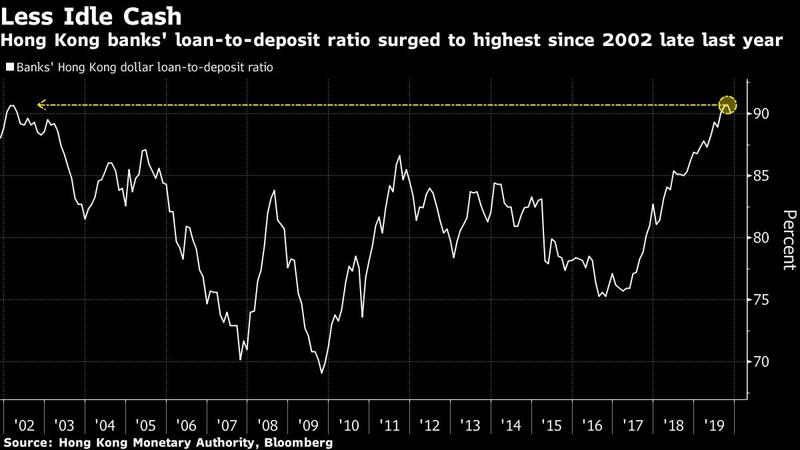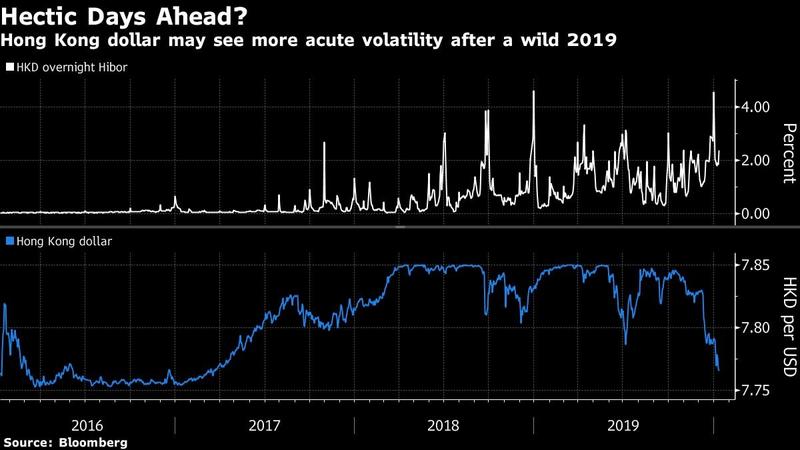One assessment of the Hong Kong dollar’s dramatic turnaround in recent months is that it’s a sign of things to come.
The moves reveal structural tightness in the city’s liquidity conditions, according to Morgan Stanley. Hong Kong banks have far less idle cash on hand, after the amount of funds on loan soared to the highest since 2002 relative to deposits. Throw in a diminished pool of interbank liquidity and potentially high demand for the currency, and wild moves in local short-term rates are likely to occur more often.
Volatility in the city’s interbank rates has been especially acute since mid December, stoking a nearly 0.8% gain for the Hong Kong dollar in a month -- a big move for a pegged currency. While analysts initially blamed the sudden strength on seasonal demand for cash and an unwind of short positions, the Hong Kong dollar has continued to gain in January. It rose to the strongest level since early 2017 last week, only months after flirting with the weak end of its trading band with the greenback.

The currency will likely fluctuate around 7.8 per greenback and stay mostly on the strong half of the trading range
Becky Liu, Head of China macro strategy at Standard Chartered Bank (HK) Ltd
ALSO READ: Hong Kong's dollar jumps into strong half of its trading band
“The currency will likely fluctuate around 7.8 per greenback and stay mostly on the strong half of the trading range,” said Becky Liu, head of China macro strategy at Standard Chartered Bank (HK) Ltd. “Interest rates will be volatile. Any large demand for cash will result in significant moves in borrowing costs when the pool of liquidity is so small.”
Liquidity in Hong Kong’s financial system was so tight last month that banks had to resort to authorities more often for short-term cash. The Hong Kong Monetary Authority -- the city’s de-facto central bank -- loaned out the most money in more than a year on Dec 31 through its discount window. Borrowing costs, known as Hibor, have edged lower since then but remained higher than the interest rates on the US dollar.
Another sign of tighter liquidity is the small aggregate balance -- a gauge of interbank cash supply. It’s down 70% over the past two years, near the lowest since the aftermath of the global financial crisis. The HKMA spent most of that money defending the currency peg as the Hong Kong dollar was repeatedly pushed to 7.85 per greenback, the weakest it can technically trade.
Making matters worse is that Hong Kong lenders’ loan-to-deposit ratio soared over recent years to 90% in November, close to the highest since March 2002, according to official data. This came as local currency savings posted the smallest increase in more than a decade in 2019, as prolonged anti-government protests threw the economy into recession.
The HKMA has previously said that financial markets remain stable.
The Hong Kong dollar’s surge since December is what happens when the city’s dwindling pool of cash meets increasing demand for the currency. Mainland investors have to buy the Hong Kong dollar to fund their purchases of the city’s stocks -- something they’ve been doing for 41 straight days. And after Alibaba Group Holding Ltd’s November share sale in the city, which temporarily locked up funds, more Chinese companies considering following suit.
Some Chinese corporates may also now prefer to hold the city’s dollars rather than the greenback for fear that trade tensions could escalate again, Standard Chartered’s Liu said. Hong Kong is seeing “structural changes” in liquidity, she added.
Tighter liquidity and wilder swings in the front-end borrowing costs will translate to the Hong Kong dollar moving “in a more volatile and less predictable pattern,“ said Chun Him Cheung, a strategist at Morgan Stanley.
Demand for the Hong Kong dollar will probably increase ahead of the Lunar New Year holidays later this month, according to Khoon Goh, head of Asia research at Australia & New Zealand Banking Group Ltd. That could briefly push the currency to the strong end of its band, he added -- which would be the first time since 2016.

READ MORE: HK's struggling dollar gets reprieve from dovish Fed
The market is already expecting further strength: on Friday, the Hong Kong dollar’s overnight Hibor surged the most in more than a week, while the one-month tenor climbed for the first time in eight sessions. The currency rose to the strongest level since March 2017, its fifth weekly gain. It weakened 0.01% to 7.7673 per dollar as of 9:35 am Monday.
The volatility in front-end Hibor is “now structurally higher” given the smaller aggregate balance, Morgan Stanley’s Cheung wrote in a note last week. “Until the aggregate balance is replenished, volatility in short-term Hibor would likely increase with each passing quarter.”


